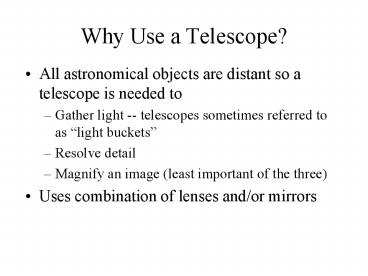Why Use a Telescope? - PowerPoint PPT Presentation
1 / 24
Title: Why Use a Telescope?
1
Why Use a Telescope?
- All astronomical objects are distant so a
telescope is needed to - Gather light -- telescopes sometimes referred to
as light buckets - Resolve detail
- Magnify an image (least important of the three)
- Uses combination of lenses and/or mirrors
2
Refracting Telescope
- Refraction as light passes from one medium to
another (e.g. air to glass) it is bent - Light is gathered and focused by a curved lens.
3
Refracting Telescope
- First telescopes were of this type
- Not made for astronomical use any more
- Very difficult to make large, defect-free lenses
- Weight of large lenses make them deform over
time.
4
Reflecting Telescope
- A curved mirror is used to collect and focus the
light.
5
Reflecting Telescope
- Used in modern telescopes
- Mirror can be supported from the back.
- Do no need large, defect free glass since surface
is coated with reflective material.
6
Focal Length
- Distance from lens or mirror to focus focal
length. - Rarely will put and eye or detector at the prime
focus. - An eyepiece (usually a lens) will be used to
magnify the image.
7
Eyepiece and Magnification
8
Telescope Design
- For a reflecting telescope, a secondary mirror is
used to reflect the image to a detector outside
of the telescope.
9
Observing the Image
- On research telescopes astronomers rarely look
through the telescope - Detector is put at the focus to record a digital
image. - Data is processed on a computer
CCD Chip
10
Telescope Properties Gathering Light
- The larger the area of the primary mirror, the
more light can be collected and the fainter the
object we can detect.
11
Gathering Light
- Can combine many smaller mirrors to make one
large area - Keck telescope primary mirror made of 36
hexagonal mirrors
12
Telescope Properties Angular Resolution
- The smallest separation in angle which can be
observed by the telescope
13
Angular Resolution
- Absolute limit of angular resolution
- best angular resolution in arcseconds
- ? wavelength (meters)
- D diameter of mirror (meters)
- Want ? to be small
- Smaller wavelengths better resolution
- Larger mirror better resolution
14
Angular Resolution
15
Angular Resolution
- Resolution usually limited by motions in the
atmosphere (twinkling) - Need site with calm, dry weather, little
atmosphere above the telescope to reduce effect. - Adaptive optics sensors monitor distortions due
to atmosphere and correct shape of mirror 10-100
times per second - Very Large Telescope (8.2 meters)
16
Adaptive Optics
Object viewed with adaptive optics
Object viewed through typical telescope
17
Hubble Space Telescope
18
Spectroscopy
- Light coming though telescope is separated by
prism or diffraction grating to produce a
spectrum.
19
Observing at Other Wavelengths
- Wavelengths other than visible are very useful
since they are often produced by different
objects or processes than optical light - Atmosphere blocks some types of light
- Low opacity Optical and Radio
- Medium opacity Infrared and UV
- High opacity Gamma Rays, X-rays some UV
20
Infrared Telescopes
- Telescope design much like optical telescope, but
with different detector. - IR light can pass through dust
- Used to observe star formation, center of
galaxies, low T objects (i.e. planets) - Best if observed above much of the atmosphere.
21
IRAS
22
Radio Telescopes
- Can observe day or night
- Not affected by Earths atmosphere
- Radio light can pass though dust in space
- Because wavelength is long, we need large
telescope to get good resolution
23
64 m telescope at Parkes Obs. in Austrailia
305 m telescope at Arecibo Observatory in Puerto
Rico
24
Interferometers
- More than one radio telescope is used to increase
resolution. - Large effective diameter
- Image made only after much computer processing
Very Large Array in New Mexico
25
Ultraviolet, X-rays and Gamma Rays
- All blocked by atmosphere
- Telescopes must be above atmosphere
Compton Gamma-ray Observatory
26
Sky at Many Wavelengths































